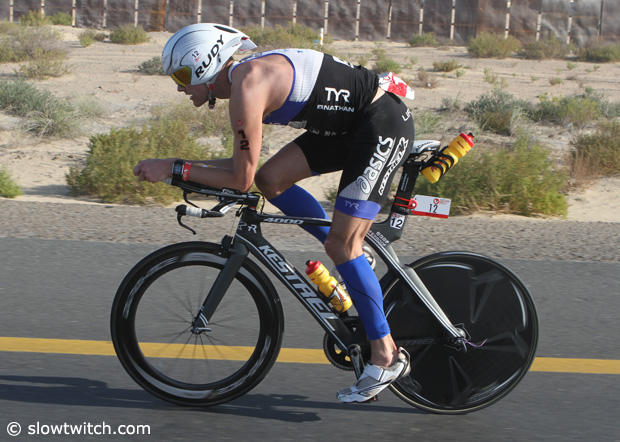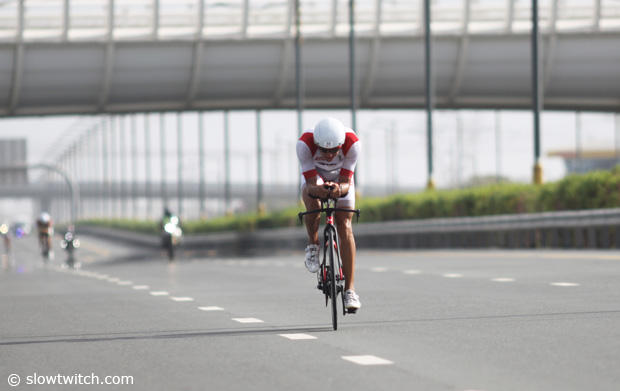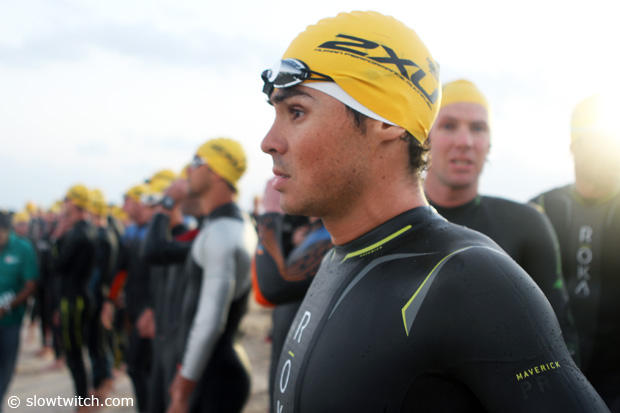The fast and smart Martin Jensen
Martin Jensen was focused and well prepared for the 2015 Challenge Dubai, but unfortunate circumstances during the race made it difficult for the fast, smart and humble Danish pro who had been missing in action the last 18 months.
Slowtwitch: Thank you for your time Martin.
Martin Jensen: Thanks Herbert. I always have time to talk to Slowtwitch.
ST: When did you return home from Dubai to Denmark?
Martin: My girlfriend and I flew back to Denmark Saturday evening, the day after the race.
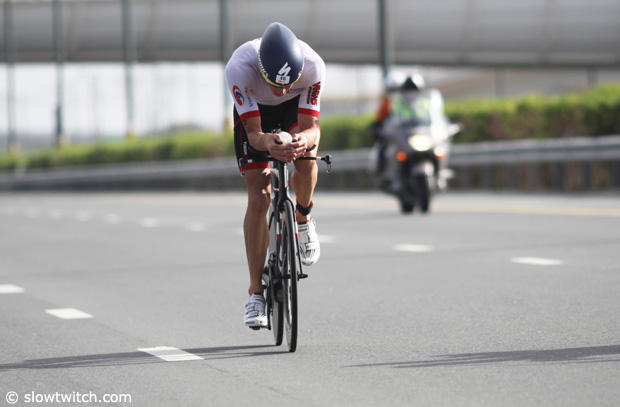
ST: You ended up in the hospital after the race. What happened?
Martin: As I was running down the finish chute I actually thought I was “home safe” in the position after Potts, but suddenly I noticed Bart Aernouts coming from behind and I made a very powerful acceleration to start my sprint for the finish line. I only managed to get a few steps in before I felt a snap in my right quad. Obviously I lost the sprint to Bart after that, and I only managed to get to the line one second ahead of a fast closing Eneko Llanos. As soon as I crossed the line I was escorted to the medical tent and stayed there for hours. It was quite painful and at the end the medical staff decided to take me to the hospital for further examinations to see if everything was okay. The services that I received from the staff in the medical tent and from the hospital were truly exceptional.
ST: How long did you have to stay in the hospital?
Martin: I was in the hospital for maybe 5 hours. I had x-ray on my leg, but everything seemed okay, and the doctors were convinced it was a tear in my adductor muscles. At the end I was sent back to my hotel on crutches. After my return to Denmark I have had both ultrasound scans and an MRI to find a diagnosis to my leg, and it has proven rather difficult to find out what is wrong. Right now it looks like some kind of stress reaction to the femur bone, but I am going in for a bone scintigraphy as soon as possible to make sure we are not missing anything. I am still only getting around on crutches, but the pain is definitely getting better.
ST: Any thoughts on when you can train again?
Martin: Hopefully I should be able to get back in to light exercise within a week or so, and then we will build from that. I use a stationary XC-Ski trainer called a ThoraxTrainer and it is very efficient yet gentle on the body when recovering from injury, so I guess that will be the first thing I’ll do in this recovery.
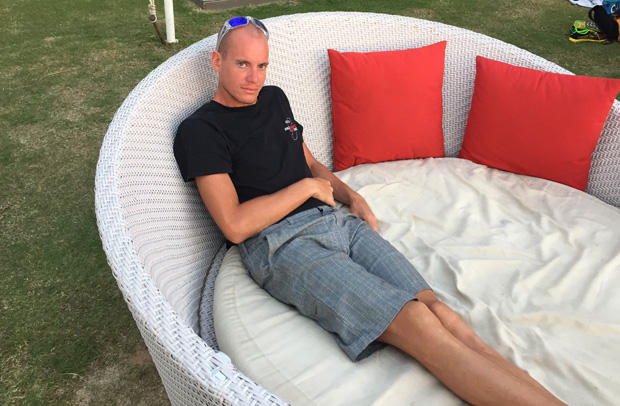
ST: When did you add Challenge Dubai to your calendar?
Martin: Actually I already wanted to race in Bahrain in December, but I was not quite ready for that after my long break due to Achilles issues. As soon as the Challenge Family announced the Triple Crown series I knew this was something that suited my style of racing and together with my coach, Michael Krüger, we put down a plan towards this specific race. We have had great success in the past with a very single-minded focus, so we were confident that I would be ready for Dubai.
ST: Why that particular race?
Martin: I have had all my best races on fairly flat bike courses, and with the new 20 meter draft rule in the Triple Crown series there was a very good chance that my strengths would end up with a good result. I love to test myself against the best in our sport, and with the prize pool available in Dubai this was certainly going to be a very high profile race. Basically the course in both Dubai and Bahrain are designed exactly like I would have designed the perfect race course for me, so obviously I was very excited heading in to this race.
ST: As the race came closer did you feel your fitness was where you wanted it to be?
Martin: My coach and I made the plan in November, and everything I did in training in this period was designed to make me as fast as possible on race day. We started out with a 2-week training camp in Austria doing lots of XC-skiing. The past has shown us that especially skating improves cycling very much and it is a perfect way to build fitness without putting to much stress on the body. After that I went straight to Club La Santa in Lanzarote. Lanzarote is the perfect place for building strength on both the bike and run. The hills and the wind there just make for some very tough training, and the conditions in Club La Santa are perfect for a training camp. As soon as I got on the bike in Lanzarote I could see some very good numbers on my SRM, and we were very happy with my form by the end of that 2-week camp. The thing about training in Lanzarote is that it is very difficult to gauge your speed on the bike. Either you go uphill, have a strong head wind or go down hill with a strong tail wind. After the camp in Lanzarote my girlfriend and I flew out to Phuket to train the last two weeks before Dubai in Thanyapura. This would be an opportunity to prepare in extreme heat and humidity and also enable me to fly into Dubai from the east making adjustments to the time difference more easy come race day. 8 days out from the race we had our final test on the bike with an 80km time trial at race pace. When I did 339w, 45.6 km/h on that test I was confident that I would have a very good ride in Dubai. The run was more of an unknown to us, as we had been building both distance and intensity during this entire period, but it is very hard to simulate what is going to happen by the end of a long and very hard race without actually doing a race. My running was definitely solid, but not quite as good as my best training leading up to previous races.
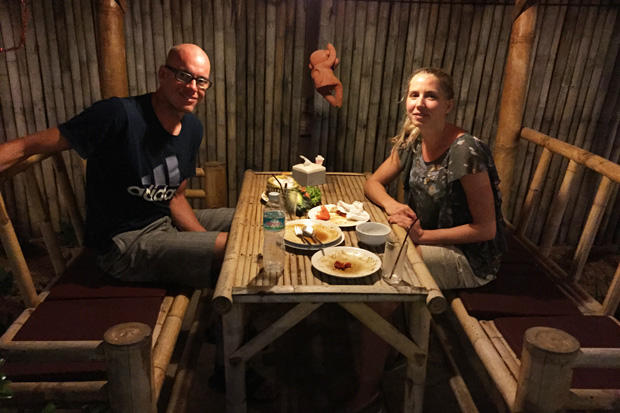
ST: I saw you a couple days before the race and you looked calm. Is that how you actually felt?
Martin: I felt pretty calm, but I was also a bit nervous to have a comeback after 18 months without racing. I knew my fitness was very good, and was just looking forward to finally get back to racing.
ST: On race morning when the winds were blowing hard, did that make your heart jump with joy?
Martin: I was definitely happy that the wind was blowing as strong as it did, but at the same time I would have preferred a non-wetsuit swim. I guess you can’t have everything the way you want it.
ST: Talk about that swim.
Martin: I had a good start to the swim and was right where I wanted to be after the first round. I fell back a bit on the second loop, but I was still in contact with the front group, so I was happy to reach T1 in the position I was in.
ST: Did you have any problem navigating?
Martin: It was difficult with the waves being as big as they were. You really have to spend a lot of energy looking for the buoys, and the people in the group were moving around a lot during the swim. I probably did a better job navigating the first loop than the second, but in the end I was where I wanted to be.
ST: Your bike split was very impressive. Were you happy with that 2:02 split?
Martin: With the conditions we had to overcome during the ride I am very happy with a 2:02 bike split. We actually expected a sub 2 hour split before the race, but that would have required some calmer conditions. I did ride the first 15km together with the front pack and there was a bit of going back and forth in the group, but as soon as we reached the high way I put the hammer down and went to the front. From there on it was just a steady grind trying to keep power between 330 and 340w all the time.
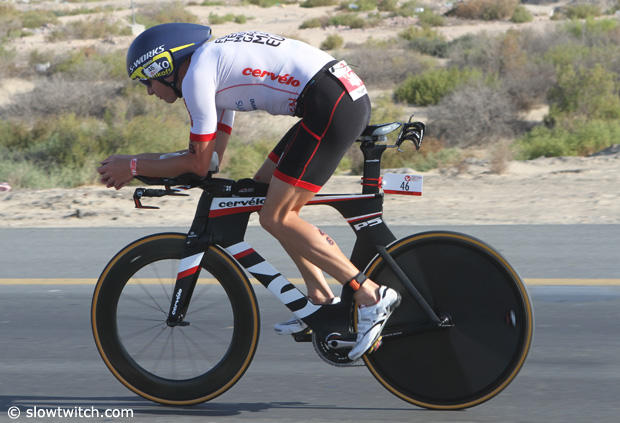
ST: Did you have a hard time with the course markings or was it fairly straight forward?
Martin: There was only one time where I had to slow down a bit to make sure I was going the right way. It was as I approached the roundabout where Bozzone, Raelert, Küng, Potts and Collins took the wrong turn. You can see me approach the round about in a youtube video from the race coverage. [link to it at the bottom]
Part of my confusion as I came into that roundabout was that I had a lead vehicle driving approximately 3-500meters up the road all the time. It was a big 4-wheel drive police car with flashing lights on the roof. As I approached the roundabout there was suddenly another of these police cars going left in the roundabout, and I had to make sure I was following the right one.
ST: When you caught Collins and Potts for the second time, were you surprised or did you know right away what had happened?
Martin: At first I was very confused. I could see two people riding up the road, and my first thought was that some local riders were out riding in the morning, making use of the fact that the roads were closed to traffic. Then as I got closer to them I could see they had race numbers on, and that really confused me. I thought I had made a wrong turn somewhere and maybe I was once again riding on the outbound leg of the bike course. When I finally made contact with Potts and Collins I realized they must have made a wrong turn, because I knew I was ahead of them at that time.
ST: Did that mess with your mind?
Martin: Of course it did. Racing is a very emotional thing. When you are in a race that is all there is on your mind, and to suddenly not being in the lead when you are supposed to was very frustrating. Would they be disqualified or not? It made me think a lot and I spent a lot of energy on that during the rest of the ride.
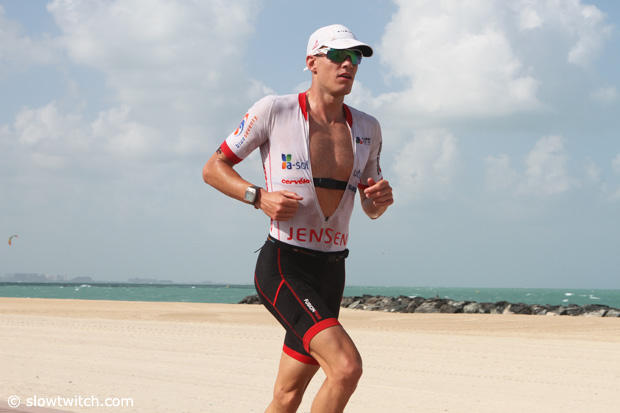
ST: You said something to me when I came by around the 60-km mark, did you also approach an official about it during the ride?
Martin: I tried to make everyone around me aware that something was wrong. That included media and race officials. Unfortunately there weren’t many race officials around me (I was riding alone and couldn’t draft off anybody), but I wanted someone to take notice of the names involved in this. At that time I didn’t know how many athletes it included, and it wasn’t until I reached T2 I knew.
ST: As you started the run, did your legs feel up to the task?
Martin: Coming off the bike my legs didn’t feel very good in the first mile or so. But after that I found a good rhythm that lasted for a good while, and I was keeping a pace of around 3.40/km for a long stretch.
ST: What about your head?
Martin: I was so angry about what had happened. I really tried to tell my self that I was running in first place instead of where I actually was, but it was very difficult.
ST: How much mental coaching advice are you getting from your coach?
Martin: We spent a lot of energy in the weeks leading in to Dubai to make sure I was in a good place mentally. We tried to plan the training sessions in a way to simulate the build up to my best races previously. Like when I raced Vineman 70.3 one week out from winning 70.3 Racine. That’s why we did a long and very hard test ride 8 days before Dubai, to gain the mental strength you get from accomplishing such a ride.
I think it is almost impossible to prepare mentally for a scenario like the one we experienced in Dubai, and you can only learn from it and bring that experience in to future situations.
ST: After you finished, did you speak to anyone about what you noticed?
Martin: As soon as I reached the finish line I talked to Zibi (CEO of Challenge Family) and told him something was wrong and that I wanted to file a protest. In the medical tent I was next to Tim Reed and I also talked to him about what happened. During my time in the medical tent Zibi came by me once more to talk about the incident.
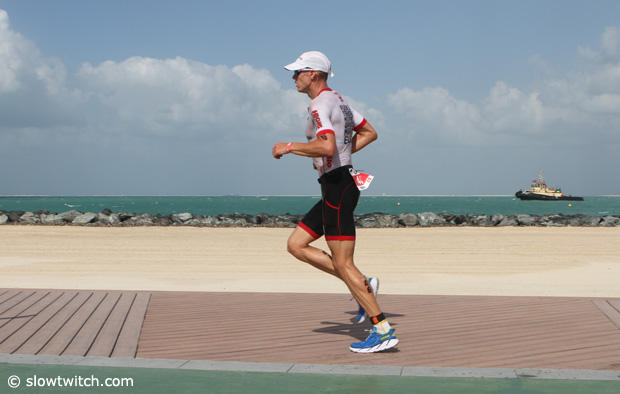
ST: Did you expect the 5 who missed the section to be disqualified?
Martin: I think they should have handled it differently. In my opinion the referees should have disqualified the 5 athletes and then they should have been the ones filing a protest. They way that I read the rules, what they did is a clear DQ. I know some of the athletes involved in the incident, and I know they would never take a short cut on the bike on purpose. It was an accident, and I think all of them have made it very clear afterwards that they are sorry about what happened. I talked to Terenzo the day after the race, and he was very sorry about the whole thing. The problem with the way they handled things is it opens up to so many what ifs. How would Tim Reed have done if he didn’t think he was 5-6 minutes down at 60km of the bike? How would Michael Raelert have done on the run had he known he was very close to 2nd place? How would I have been able to run, had I started the run with a ~4 minute lead? Nobody knows, and that is why it is so difficult.
ST: I think you learned about the 4-minute time adjustment in the hospital. For you I guess that was a $14,000 difference. A DQ and you would have been 3rd and won $20,000. But for 5th place I guess it was $6,000.
Martin: Obviously there is a rather significant difference in 3rd and 5th place for me, but it is not only about financial gain. To me it is also a matter of sponsorship exposure that I didn’t get during the coverage of the race. It is a matter of acknowledgement of the performance that might be the strongest performance I have ever put out in a 70.3 distance race. If you look through the results I don’t even get the recognition of having the fastest bike split. I don’t do triathlon to become rich. Otherwise it would be so much better for me to use my engineering degree in a civil job. I race because I have dreams and goals, and want to show that I am a world class triathlete. I have overcome so many injuries during my career, and it is the dream of putting out races like I had in Dubai that keeps me going where many would have quit a long time ago.
ST: I know you said it is not just about money, but also many sponsors now only pay bonuses for podium finishes.
Martin: That is true. The feedback that I have received from my sponsors after the race has been incredible, and it seems like most of them treated me like I was number 3 overall.
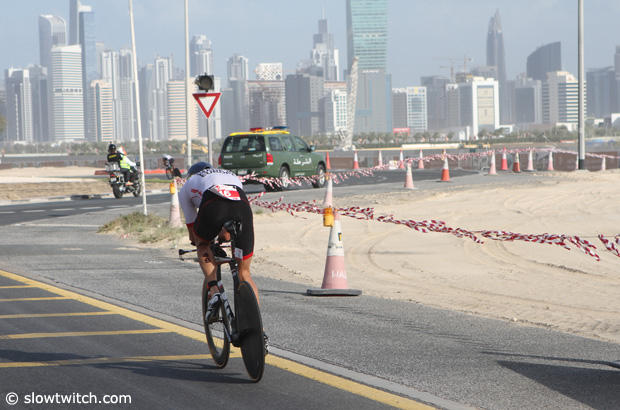
ST: You also missed out on being first back into T2.
Martin: That is right. Nobody knows what would have happened if I had reached T2 with a ~4 minute lead on everybody.
ST: Did you talk with the Challenge folks after the race?
Martin: I have had some communication with the Challenge folks after the race, but I think they have spent a lot of energy discussing how to handle this whole mess as best as possible. Things are still not settled, so we will have to see how this all end up.
ST: Will you do Challenge Oman and Bahrain?
Martin: I really hope so. I love what Challenge are doing for triathlon with the new Triple Crown series, and I love to race these big races, so obviously I want to come back for the next races. Also, I really feel that I have something to prove now – Dubai was not just a lucky punch for me!
ST: What else is on your calendar?
Martin: Another important race in my calendar is the ITU Long Distance worlds in Sweden this summer. I don’t plan on Kona this year, but will add races to my calendar as I progress during the season. 70.3 worlds in Austria this year is also very interesting, so I will have to look into qualifying for this one as well.
ST: Plus it is relatively close.
Martin: That is definitely a huge benefit. Traveling to races is expensive, so to have a World Championship race that is basically within driving distance from Denmark is really something that I look forward to.
ST: To be honest, I was shocked to learn that you have no bike sponsor this year. Is the problem to some degree that you are too particular about it?
Martin: I am very particular about my bike for sure, and have been that no matter if I have been riding a Scott, Blue, Ceepo or Cervélo! It is a difficult situation, as I got a P5 for free from Cervélo in 2014 but didn’t really race at all in 2014. Coming back from a long injury it is very difficult to get sponsorships, so I was actually waiting until I was past my first race before I wanted to put an effort into sponsorships. So for now I decided to just race on my P5, as it is a very fast bike. I run quite a successful coaching business in Denmark, with my fastest athlete going 8.03 on the full distance in 2014. That is the main source of my income and I really like to have my income separated from my racing results.
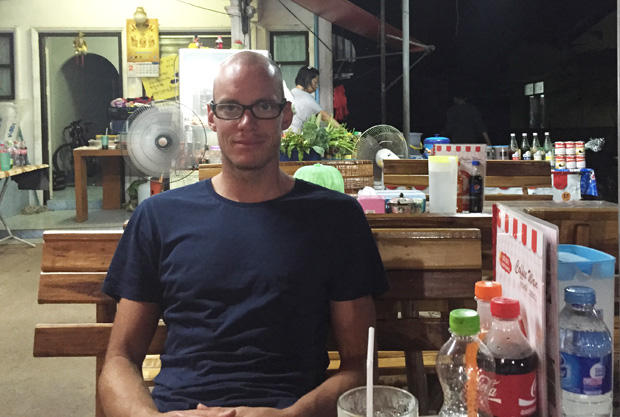
ST: Any update regarding that situation since your superb performance?
Martin: Not as of yet, but lets see in the near future.
ST: Keep us posted.
Martin: Sure, I’ll do that.
The youtube video Martin mentioned can be found here and you can follow him on Twitter via @jensentri.


